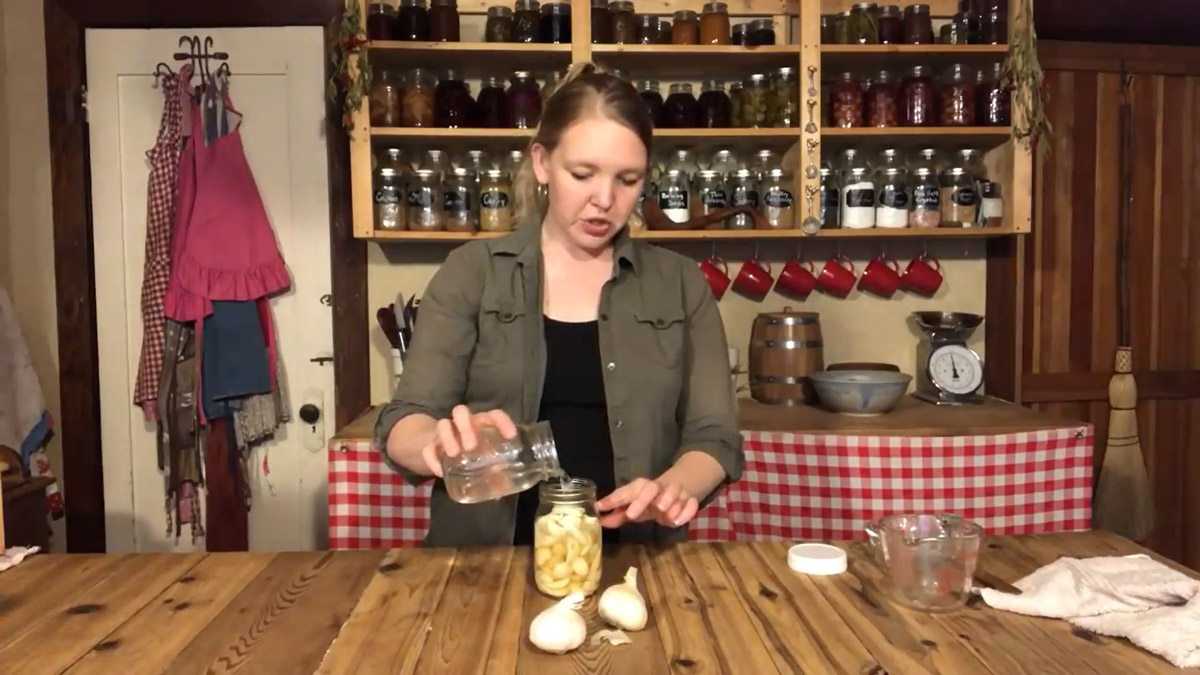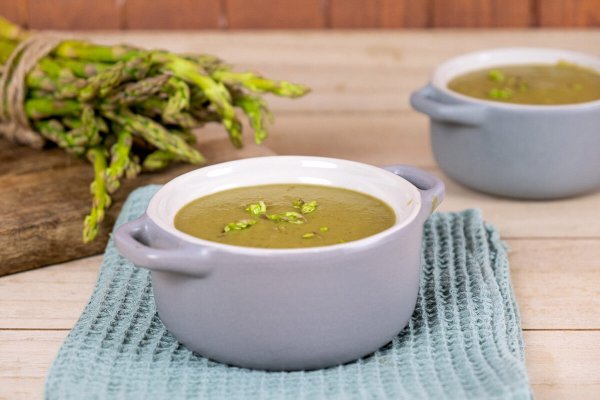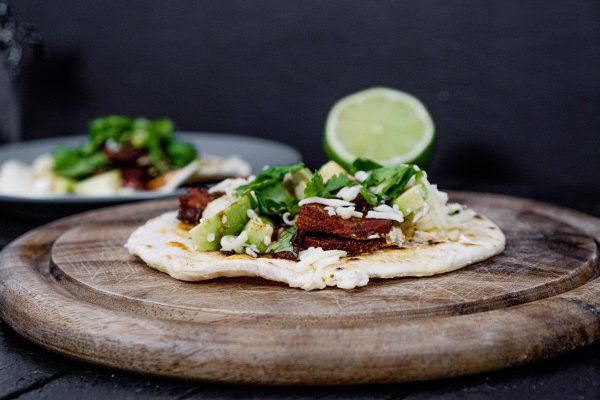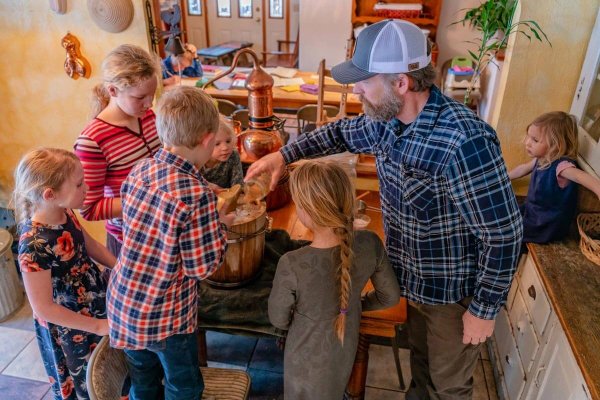Pickled garlic, or lacto fermented garlic, is easy to make. Use it in your favorite sauce or pickle recipe or eat it raw and enjoy its health benefits.

We plant garlic in our fall garden every year. Garlic is a staple in our home for our meals and our health.
We use garlic to make everything from roasted garlic to a garlic salve for colds and coughs, refrigerator dill pickles, homemade bone broth, or to add to any meal that calls for garlic. We love to add it to stir-fries!
With garlic being a prevalent ingredient in our home, we use fermentation as one way to preserve it. Lacto fermented garlic is easy to make, easy to use, and full of health benefits. Check out our Guide to Fearless Fermenting if you’re new to fermenting or to get some great recipes and tips.
Why We Ferment Garlic
You may have heard about the health benefits of the fermentation process. It adds good probiotic bacteria to your food. But fermentation is also a fantastic method used to preserve food.
We choose to ferment garlic as one of our preservation methods so that our garlic will last. When we harvest garlic, we peel a large quantity at once and preserve it by fermenting it. It will last six months to a year in the proper storage conditions.
If you find that your garlic is starting to age or if you have a large harvest of garlic, try fermenting it to preserve it for later use.

Is Garlic Safe to Ferment?
Fermenting vegetables like garlic is an effective and safe method for preserving foods when done correctly.
Before you begin fermenting foods, do your research. It is helpful to understand the basics of fermentation as a preservation method. Many people choose fermentation as a long-term preservation method for its safety, ease, and health benefits.
If you love garlic salt as Josh does, then plan to dehydrate or freeze-dry some of your garlic to make homemade garlic salt.
Does Fermented Garlic Taste Good?
When you open a jar of fermented garlic, the aroma smells heavenly! The taste is even better, especially if you are a garlic lover.
When you ferment garlic, it remains raw. Fermenting garlic mellows the delicious, spicy flavor of raw garlic, making it more easily consumable but still delightfully garlicky. The taste may be overwhelming for some people, but the health benefits make it worth eating.
You can eat fermented garlic straight from the jar or make garlic-infused honey to help boost your immune system during the cold and flu season. You will gain all the healthy bacteria and probiotics from the fermentation process and all the great natural benefits of raw garlic.

What is Pickled Garlic (or Fermented Garlic) Good For?
As mentioned above, eating raw fermented garlic offers immune support. But, use fermented garlic in any recipe that calls for garlic.
To use fermented garlic, pull what you need from the jar, slice it or mince it, and add it to your meals. Enjoy the simplicity of using garlic that is already peeled and ready to use.
When you cook fermented garlic, you lose the probiotic benefits from the fermenting process. But, when you ferment garlic, even to cook with, you are gaining the ability to make your food last for much longer than in standard storage.

Supplies
- Pint-Sized Mason Jar – You can fill a quart jar if you have a lot of garlic to ferment or any other fermentation vessel (read this post on the best fermentation vessels). Just adjust the recipe accordingly.
- Mason Jar Lid – The plastic, screw-top style lid works well with this recipe. It does not seal tightly, leaving room for gases to escape while fermenting. Or, you can use specialized products like these fermentation lids so that you don’t have to burp the jar.
- Small Mixing Bowl – You can use a liquid measuring cup as a mixing bowl to save on dirtying one more dish.
- Spoon – Use a stainless steel spoon or a clean and dry wooden spoon.
- Measuring Cup – Use a liquid measuring cup to measure the liquid and use it as the mixing bowl.
- Tablespoon – Some people guess and use approximate measurements in these recipes, but be extra careful by measuring the amount of salt needed in this recipe precisely. You do not want to skimp on the salt.

Ingredients
- Raw Garlic – Peel garlic cloves down. You do not need to cut the ends off. Make sure you peel enough to fill the pint jar almost to the top.
- 1/4 Cup Starter Liquid – For this starter liquid, you can use the juice from something fermented or cultured. Use whey from cheesemaking or whey drained from plain yogurt as long as it does not contain thickeners or additives. Use kombucha, the brine from homemade sauerkraut, or the brine from any other fermented foods, like fermented tomatoes.
- 1 Tablespoon Pure Salt – Any salt will work, but I prefer pure salt that does not contain additives or colorization. I recommend Redmond Real Salt. (Using that link for Redmond Salt will automatically give you 15% off your order!)
- 1/4 Cup of Water – You may need to adjust the amount of water at the end of the recipe to ensure the liquid fully covers the garlic cloves.


How to Make Pickled Garlic (Fermented Garlic)
Now that you know why you need fermented garlic in your life, you are probably asking, “How do you ferment garlic?” These instructions will guide you through the very simple process.
- Take your heads of garlic and separate each clove. Peel the garlic cloves entirely. You do not need to cut off the ends.
- Put the whole, raw cloves of garlic into the pint-sized jar. Leave at least an inch of space at the top of the jar.
- In a liquid measuring cup, measure ¼ cup of the starter liquid you chose. I like to use homemade kombucha as a starter for fermented garlic. If you do not have a starter liquid, use ¼ cup of water and double the salt you add.
- Add one tablespoon of pure sea salt to the starter liquid and stir them together. The brine may foam or fizz as it reacts to the salt.
- Add ¼ cup of the water to the brine (or water) and mix until the salt dissolves.
- Now add the brine to the pint jar of garlic. Be sure to leave an inch of head space in the jar.
- Keep garlic under the liquid level. You may need a weight to keep the garlic down. But, I prefer my method of shaking the jar periodically for the first three days. Give your jar a good shake every time you come through the kitchen to disrupt any mold that may be trying to form.
- Leave the pint jar of garlic on the counter at room temperature for at least three days, shaking it periodically. During these first few days, you may see fizz or bubbles forming. This reaction of the fermentation process will calm down, indicating when it is ready to use or store.
- You can use fermented garlic immediately, as the flavor tastes good after only three or four days. Or, you can store it in cool storage at a stable temperature of 55℉ or lower. It will last for six months to a year when stored properly.



Did you make this recipe? If so, we’d love for you to leave a star rating in the recipe card below. Then snap a photo of all the ways you’re using your fermented garlic and tag us on social media @homesteadingfamily so we can see!
More Recipes You May Enjoy
- Fermented Ketchup (Easy, Homemade, Probiotic & Kids Love It)
- Curtido Recipe
- Preserved Limes with Fermentation
- Cherry Almond Flavored Kombucha
- Homemade Fermented Ginger Carrots
- Lacto-Fermented Sauerkraut
- Preserved Lemons
- Easy Homemade Lacto-Fermented Mayo
- Lacto-Fermented Green Beans (Pizza Beans)
- Fermented Tomato Sauce – Just 3 Ingredients!
- Fermented Tomatoes
- Fermented Cranberry Sauce

Fermented Garlic (Pickled Garlic)
Equipment
- Pint-Sized Mason Jar + Lid
- Small Mixing Bowl
- Measuring Cup
- Spoon
Ingredients
- 2 cups garlic cloves peeled
- 1/4 cup kombucha see notes below
- 1 tablespoon salt
- 1/4 cup water filtered or spring water
Instructions
- Take your heads of garlic and separate each clove. Peel the garlic cloves entirely. You do not need to cut off the ends.
- Put the whole, raw cloves of garlic into the pint-sized jar. Leave at least an inch of space at the top of the jar.
- In a liquid measuring cup, measure ¼ cup of the starter liquid you chose. If you do not have a starter liquid, use ¼ cup of water and double the salt you add.
- Add one tablespoon of pure sea salt to the starter liquid and stir them together. The brine may foam or fizz as it reacts to the salt.
- Add ¼ cup of the water to the brine (or water) and mix until the salt dissolves.
- Now add the brine to the pint jar of garlic. Be sure to leave an inch of head space in the jar. Add more water, if needed.
- Keep garlic under the liquid level. You may need a weight to keep the garlic down. But, I prefer my method of shaking the jar periodically for the first three days.
- Leave the pint jar of garlic on the counter at room temperature for at least three days, shaking it periodically.
- You can use fermented garlic immediately, as the flavor tastes good after only three or four days. Or, you can store it in the refrigerator or cool storage at a stable temperature of 55℉ or lower. It will last for six months to a year when stored properly.
Notes
- You can use other starter liquids such as kombucha, kefir, sauerkraut juice, fermented pickle juice, whey or yogurt.
- During these first few days, you may see fizz or bubbles forming. This reaction of the fermentation process will calm down, indicating when it is ready to use or store.
- Store fermented garlic in the refrigerator or cool storage at a stable temperature of 55℉ or lower.
- Fermented garlic will last for six months to a year when stored properly.
















